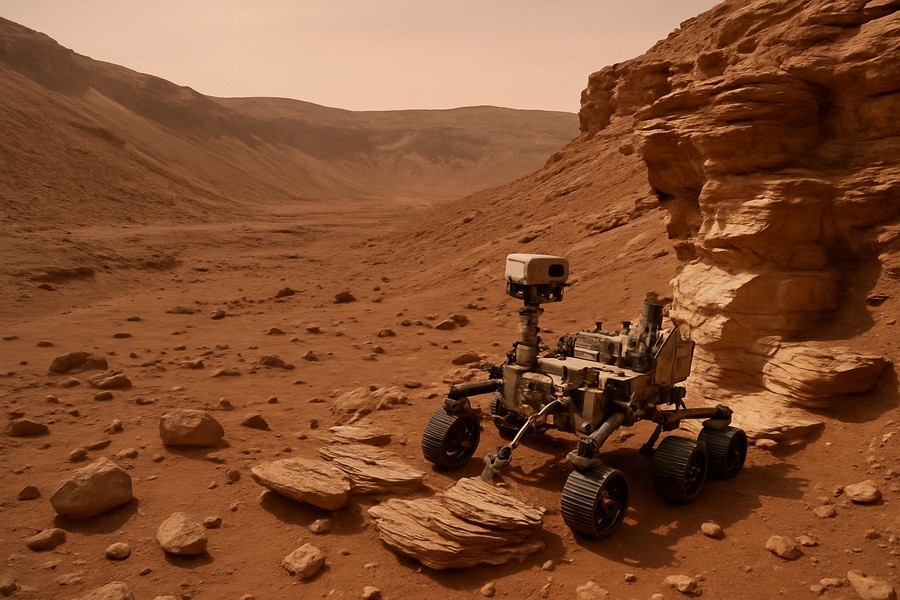
Evidence of Past Microbial Life on Mars Suggested by Rover Findings
An international team of researchers, including a geologist from a leading Texas university, has discovered potential signs of ancient microbial life on Mars. These indicators were found in Martian rock samples analyzed by a high-tech rover.
The fascinating discoveries center on a section of Jezero Crater, known as the Bright Angel formation, named for its light-colored rocks reminiscent of the Grand Canyon. The Neretva Vallis channel of Mars, home to the Bright Angel, is rich in fine-grained mudstones containing oxidized iron (rust), phosphorus, sulfur, and notably, organic carbon. This unique combination of elements could have supplied early Martian microorganisms with a vital source of energy.
A Surprise in Martian Rocks
When the rover started its exploration of the Bright Angel, the unique composition of the local rocks was quickly noticed by the team. These rocks showed signs of chemical cycling, a process that Earthly organisms use for energy creation. Upon closer examination, there were more signs that were hard to explain without considering the existence of early Martian life.
Life forms tend to perform chemical reactions that occur naturally in the right conditions over time. According to the researchers, the chemistry that shaped these rocks required either high temperatures or life. However, there was no evidence of high temperatures. The intriguing findings call for further experiments and lab studies on Earth to definitively rule out non-biological explanations.
Mars's Watery Past
The Bright Angel formation is made up of sedimentary rocks deposited by water. This includes mudstones and layered beds, suggesting an environment marked by flowing rivers and still water. The rover's advanced instruments detected organic molecules and mineral arrangements possibly formed through redox reactions, a type of chemical process involving the transfer of electrons. Such reactions on Earth are often driven by biological activities.
Perhaps the most interesting features are tiny nodules and reaction fronts, endearingly nicknamed "poppy seeds" and "leopard spots" by the rover team. These are rich in ferrous iron phosphate and iron sulfide, minerals that often form in low-temperature, water-rich environments, and are usually associated with microbial metabolisms.
The Role of Organic Matter
The study found a specific organic carbon signature, known as the G-band, in several Bright Angel rocks. The strongest signals were detected in an area called "Apollo Temple", where the presence of both ferrous iron phosphate and iron sulfide was most abundant.
However, it's important to note that "organic" doesn't necessarily mean formed by living organisms. Organic matter can be formed by other processes, and the type detected in this study could have been produced by non-living processes. If produced by living organisms, it would have been degraded by chemical reactions, radiation, or heat to produce the detected G-band.
The study proposed two possible scenarios: one where these reactions occurred abiotically (driven by non-living processes) and another where microbial life may have influenced the reactions. Interestingly, while some of the nodules and reaction fronts could be produced by abiotic reactions, the processes that could have produced sulfur-associated features usually only occur at high temperatures.
Potential Biosignatures
Despite the lack of high-temperature evidence, the possibility of these features being created by bacterial-like organisms living in Martian mud over three billion years ago cannot be ruled out. While the evidence doesn't definitively prove the existence of past life on Mars, the findings meet NASA's criteria for "potential biosignatures"—features that warrant further investigation to determine whether they are biological or abiotic in origin.
A Valuable Sample for Future Study
The rover collected a core sample from the Bright Angel formation, now sealed and stored within the rover. This sample is among those flagged for potential future return to Earth.
Bringing the sample back to Earth would allow further analysis with more sophisticated instruments than those currently on Mars. Researchers could examine the isotopic composition of the organic matter, the fine-scale mineralogy, and even search for microfossils if they exist. Further tests could determine the highest temperatures experienced by these rocks and whether high-temperature geochemical processes might still be the best explanation for the potential biosignatures.
According to the geologist, the similarities between Martian and terrestrial processes are striking, raising the fascinating possibility that life may have been utilizing the same processes on Earth and Mars at roughly the same time.
